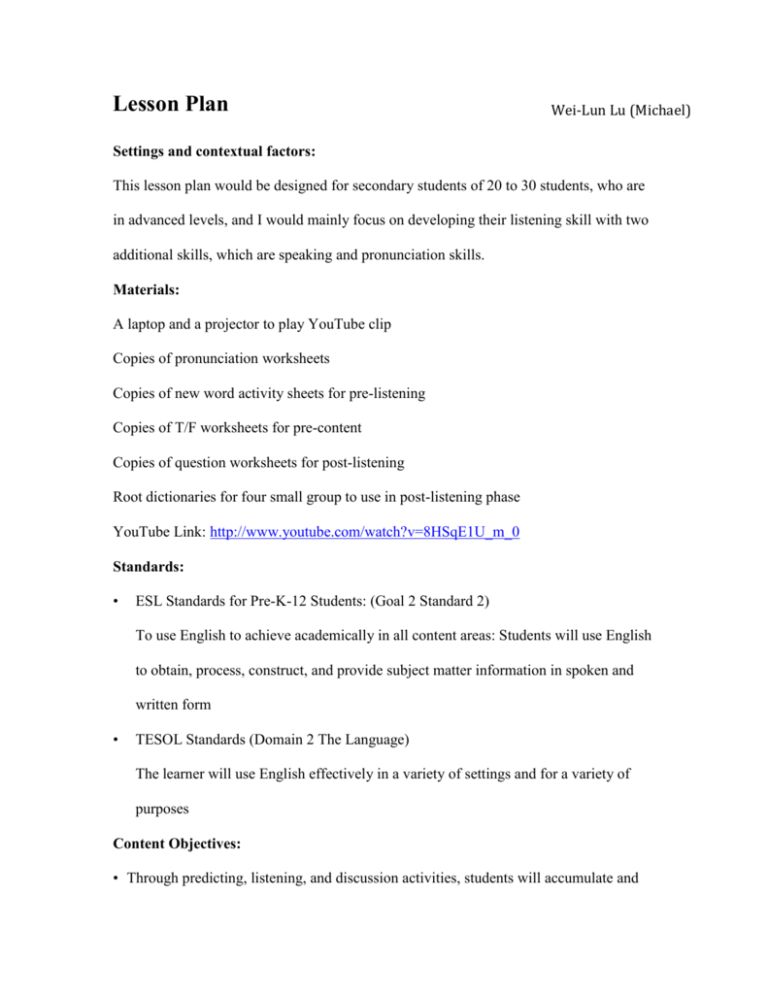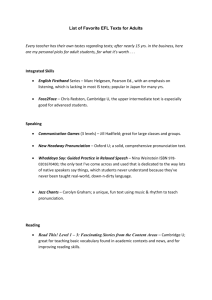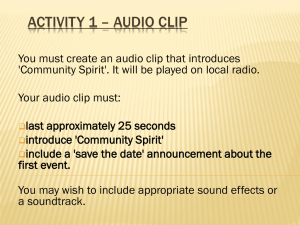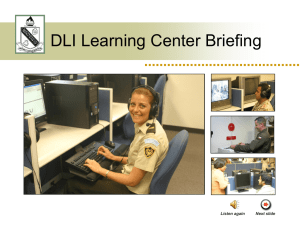Lesson Plan
advertisement

Lesson Plan Wei-Lun Lu (Michael) Settings and contextual factors: This lesson plan would be designed for secondary students of 20 to 30 students, who are in advanced levels, and I would mainly focus on developing their listening skill with two additional skills, which are speaking and pronunciation skills. Materials: A laptop and a projector to play YouTube clip Copies of pronunciation worksheets Copies of new word activity sheets for pre-listening Copies of T/F worksheets for pre-content Copies of question worksheets for post-listening Root dictionaries for four small group to use in post-listening phase YouTube Link: http://www.youtube.com/watch?v=8HSqE1U_m_0 Standards: • ESL Standards for Pre-K-12 Students: (Goal 2 Standard 2) To use English to achieve academically in all content areas: Students will use English to obtain, process, construct, and provide subject matter information in spoken and written form • TESOL Standards (Domain 2 The Language) The learner will use English effectively in a variety of settings and for a variety of purposes Content Objectives: • Through predicting, listening, and discussion activities, students will accumulate and show their understanding of what is obesity Language Objectives: • Distinguish, and effectively use the sounds of ten and teen such as 15 and 50 in English • Understanding and producing technical vocabulary and text features according to content area Learning Strategies: • Use contextual clues to figure out meanings of new words • Use top-down processing and take notes when a teacher presents information or during a YouTube clip in order to summarize key concepts • gather and organize the appropriate materials needed to complete word root sheets • use bottom-up processing to locate specific detail information about obesity from a YouTube clip to answer T/F questions Learning processes: Pronunciation Activity: (Language Objective) (20 min) distinguish numbers of ten and teen such as 15 and 50 The teacher give each student a pronunciation sheet copied from a textbook, WELL SAID The teacher explains how to pronounce numbers of ten and teen The teacher follows the exercises from the worksheets to let students getting familiar with numbers of ten and teen The teacher asks students to pay attention to questions relative to numbers when listening to the YouTube clip to answer T/F questions in during-listening phase Pre-listening activity: (Language Strategy) (10 min) Learning new words The teacher gives each student a worksheet including several multiple-choice questions. Students’ job is to find out the correct meanings of new words from multiple-choice questions by looking at contextual clues in the worksheet Students compare and discuss their answers with someone sitting next to them The teacher read the correct answers to students, and then students correct their answer by using a different color pen The teacher collect their worksheet for further assessment Pre-content activity: (Content Objective and Language Stratage) (20 min) True/False questions The teacher gives each student a T/F question worksheet In groups, students answer the T/F questions based on their background knowledge In groups, students predict the big idea of the following listening clip by reading and discussing the T/F questions The teacher asks for volunteers to share their prediction to the whole class Ten minutes between two 50 minute sections During-listening: (Content Objective and Language Strategy) (15 min) Listen to the YouTube clip First time listening: listen to the content in groups of four Second time listening: listen to the details, revise their answers and discuss their answers in their small group of four Third time listening: listen to the details, especially those details they didn’t catch on the second time listening, and those details didn’t meet the agreement among students in their small groups of four The teacher read the correct answer to students and collect their T/F worksheets for further assessments After-listening: Discussion activity: (Content objective) (10 min) Discuss questions relevant to the topic –obesity The teacher gives each group a discussion worksheet including questions relative to the topic In groups, students discuss those questions from the discussion worksheet One minute speech: (Language objective) (15 min) Students are given 10 minutes to prepare their one minute presentation by using numbers of ten and teen such as 14 and 40, and new words learned from the listening clip They would be asked to use questions from previous discussion activity to prepare their one min presentations Each student would give his/her presentation to three different students and would listen to three different students’ presentations The last time they change their partners, they go back to their original partners, and then the teacher give each student a rubric as a assessor to assess his/her original presenter Discovering word root activity: (Language objective) (10 min) In groups, each student is given a new word sheet of new words learned from the listening clip Students’ job is to explore how to memorize these new words by using various resources the teacher give The teacher gives all the resources needed to students Each group assigns a volunteer to share what they find of how to memorize these new words Assessment: Pronunciation activity: • Each student will be assessed by his/her listener through one minute presentations. Students would be required to use numbers of either ten or teen such as 15 or 50 at leases one times in their presentation to show they can to pronounce numbers of ten and teen correctly and can be understand by their listeners. After the one min presentation activity, the teacher collect their rubric and their scripts of one min presentation to see whether they use new words and numbers required in their presentation. Pre-listening assessment: In this phase, I would collect and look at students’ new word worksheets to assess their ability of whether they are able to use the strategy of using contextual clues to figure out meanings of new words, their new word worksheets would help me to monitor my students and give personal assistant to students, who might not perform well in this language strategy. Pre-content assessment: Here I would not assess my students. They share their prediction of what they are going to listen to in their small groups and with the teacher. During-listening assessment: Students in this phase would listen to the YouTube several times to negotiate their content and detail answers with other students in their small groups. The teacher’s role would act as a helper and assistant walking around to assist group negotiation, to assess students’ speaking productive skill, and to observe their engagement of group discussion, then collecting their T/F worksheets to assess the way how they revise their T/F question sheets. After-Listening assessment: Discussion activity assessment: In this phase, I would simply walk around each group to see whether they are welling to use English to share their opinions. Here, their speaking would not be assessed. One minute speech activity assessment: In addition to ask students to use numbers like ten and teen in their presentations, I would ask students to use at lease 5 new words learned from the clip in their presentations. Like mentioned in pronunciation assessment, each presenter would be assess by his/her listener from a given rubric. After students give their presentations to their listeners, the teacher would collect their rubrics and scripts for further assessment. Rationale: According to Chamot (1995), humans can process new information from short-term memory to long-term memory if the new information is able to be survived and stored long enough in human’s brain by activating them several times (p. 16). Therefore, in this lesson I mainly follow the principle learned from Chamot’s article on designing activities, which help students store new information in long-term memory. Activities including pre-listening, pre-content, listening to a clip, discussion, one minute presentation, and word root activities are all serve the principle of cognitive learning theories. Pronunciation activity: The reason why I would spend 20 minute to teach students pronunciation in my lesson plan is because students need to have correct pronunciation to produce comprehensible speech (Goodwin 2021; Wang 1987), otherwise others might misunderstand when communicating each other. In this lesson plan Through the connection between the pronunciation book called Well Said and the YouTube clip of obesity, students would be able to distinguish, practice, and use numbers of ten and teen such as 50 and 15 both from the clip and the book in the end of this lesson. Pre-Listening and Pre-Content activities: The reason why I have pre-listening and pre-content activities in my lesson plan is because “ listening tasks in the classroom, just like reading tasks, are far more demanding if children have no previous knowledge on which to draw” (Rost 2002 p.104). Thus, these warm-up activities would give students little background knowledge before they get start to listen to a clip I choose. According to Helgesen and Brown (2007), “ in many warm-up activities, learners do tasks to activate their schemata – essentially reminding themselves of cpntent related to what they will here as well as vocabulary and, at times, forms that will carry the content” (p.10). During-Listening activity: In during-listening, I would adopt the use of top-down and bottom-up processing in class because they are basic but crucial for learners to process new information. Richard (1990) stated “ bottom-up processing refers to the use of incoming data as a source of information about the meaning of a message.” However, “top-down processing, on the other hand, refers to the use of background knowledge to understanding the meaning of a message” Richard (1990). They are different skills and should be equally taught in class. In Taiwan we are too much focus on bottom-up processing no matter from reading or listening; and the results has turned out that even a high English proficiency student has difficulty to come up with main idea or gist from a talk or speech. Thus, this is why I would have both processing in my lesson plan. Post-Listening activities: In post-listening, there would be three activities used: discussion, one minute presentation, and word root activities. The role of discussion serves to practice students’ active and productive skills (Helgesen and Brown 2007). It provides students an opportunity to use the target language in class, where most Taiwanese EFL English teachers don’t do. Needless to say, it also gives students a chance to cultivate and show their critical thinking skill. The role of one minute presentation and word rood activities is to reinforce their memory of new words learned from the YouTupe clip. Students through the preparation of one minute presentation, the performance of it, and the exploration of word roods may activate their brains to move new words from their shortterm memories to long-term memories. I have spent times on collecting useful resources to make this lesson plan practical. I hope the notions and the activities I adopted from readings, textbooks, and experienced ESL teachers can really help English learners make progress in my future class. References: Chamot, A. (1995) Learning strategies and listening comprehension. In Mendelsohn, D. J., & Rubin, J. (Eds.) A guide for the teaching of second language listening (pp. 13-30). San Francisco: Dominie Press. Gibbons (2002) Listening – An active and thinking process. In Scaffolding language, scaffolding learning (Chapter 6). Portsmouth, NH: Heinemann. Goodwin, J. (2001). Teaching pronunciation. In M. Celce-Murcia (Ed.), Teaching English as a second or foreign language (pp. 117-133). Boston, MA: Heinle & Heinle. Helgesen, M. & Brown S. (2007). Practical English Language Teaching: Listening. New York, NY: McGraw-HillESL/ELT. Lazaraton, A. (2001). Teaching oral skills. In M. Celce-Murcia (Ed.) Teaching English as a second or foreign language (3rd ed.) (pp. 103–115). Boston, MA: Heinle & Heinle. Richards, J. (1990). Designing instructional materials for teaching listening comprehension. In, The Language Teaching Matrix (pp. 50-66). New York: Cambridge University Press. Wong R. (1987) Teaching Pronunciation: Focus on English Rhythm and Intonation. New Jersey Prentice-Hall, Inc.







